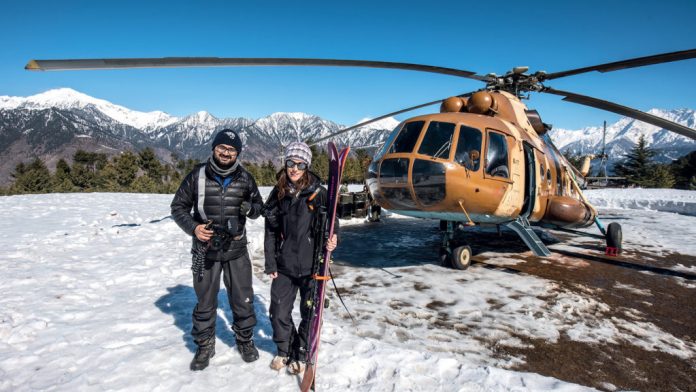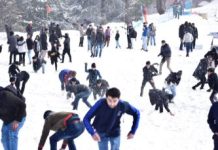There are destinations that make you dream. Those who evoke adventure, discovery, exoticism. In my mind, Pakistan was in this category
This country particularly attracted me for its size, with its mountains among the highest on the planet, but also for its culture and the guarantee of a true experience, far from the tourist flows.
So when Brice Lequertier, of Elite Ski Travel, offered to accompany him to Pakistan to film a big heli-skiing operation, I did not hesitate for a second to embark on this exciting project. The initiative came from the company Afiniti, whose founder, originally from this country, wanted to invite his collaborators around the world with the idea that we all gain to know each other better, especially when the meeting is made in a framework as powerful as that of these massifs.
An adventure is certainly richer if it is shared. We were there a great team around sixty guests: fifteen guides from Canada, the United States, France, Chile, Italy and the Canaries, assisted by as many shimshalis, these formidable mountaineers who accompany expeditions on the highest peaks, such as sherpas in Nepal.
A lot of people also for all the logistics, as well as for the images. We were three cameramen and a photographer, specialized in filming in the mountains: Grego Campi, Argentinian, Jonathan Viey, Franco-Swiss, Philippe Rebreyend, French photographer, and myself. Nisar Malik, whose work you no doubt admired in BBC’s Planet Earth, was there also with five Pakistani cameramen with whom we worked closely. Some days one of the helicopters was requisitioned for the Cineflex shots, operated by British. An international team united around the same passion!
For a shoot of this type, efficiency and mobility take precedence. Helicopters cannot wait for a cameraman to set up and skiers too want it to move forward, especially for safety reasons. For the sequences of life in the villages, we want to capture unique moments, which will not happen again. The cameras must therefore be reactive, quick to set up and require little accessorization.
The ideal is to have one constantly on you, ready to shoot. It can be around the neck, on the stomach, in a bag or fixed on a plate on the strap of the backpack with the Peak Design accessory. This keeps your hands free while being able to access the device instantly. This allows, in the mountains, to be comfortable to move since we have both hands available to ensure, push on sticks and benefit from a better balance downhill.
To be able to keep your camera on you all day long when you are in the mountains, that is to say to jump from a helicopter in deep snow, get on ski touring and get off on skis or snowboard in all snow and all terrain, it must of course be as compact and light as possible.
To protect yourself as much as possible from an accident in an avalanche, it is recommended to equip yourself, in addition to the essential avalanche victim detector (DVA) triptych + shovel + probe, with an airbag that can be inflate in the casting to keep its wearer on the surface. These bags have the disadvantage of being heavy and generally not very spacious, cameramen are often forced to do without them in order to be able to transport all their equipment, to the detriment of their own safety. In these Himalayan mountains where it snows abundantly and where you ski far from everything, I was reassured to be able to carry my things in a bag of this type.
Because of the isolation, you have to be able to count on your equipment. It is not possible to repair it or find a replacement. However, it is in high demand. When a large troop transport helicopter lands in front of us, the breath blows the snow with force, so it is better that its housing is robust and well tropicalized to prevent water from entering the joints.
Pakistan has five peaks of over eight thousand meters, including the famous Nanga Parbat, nicknamed the killer mountain for easily understandable reasons, which is located in the massif in which we were evolving, namely the Himalayas. Around these majestic peaks stands a number of very high altitude peaks, so much so that the locals call mountain those that exceed six thousand meters and hills those lower. In their eyes, there is therefore not a mountain in Europe!
The helicopters struggling to fly very high and the organisms suffering too much, we stayed at more modest altitudes, around four thousand meters. However, temperatures in February in these areas are negative, and therefore lower than the operating temperatures indicated by the camera manufacturers. With the experience of this type of shooting, we learn to identify those who resist better than the others in such an environment. The same goes for batteries, whose reliability is paramount on this type of shooting.
The choice of cameras
With the multiplication of operators also necessarily comes that of cameras. We were therefore able to test a whole range of models in this particular context. Grego chose the Sony Alpha7R, our Pakistani friends from several Alpha7 II and a Blackmagic Ursa, Jonathan from the Panasonic S1R. For my part I embarked two Z series cameras lent by Nikon France: the Z7 and the Z50, with a wide range of optics ranging from wide-angle, very useful in helicopters, to telephoto for filming skiers from the opposite slope, via the ultra-practical 24-70 mm zoom lenses. The photographer working at the Nikon D810, we could have exchanged F-series optics if I had taken the adapter ring, but I was fully satisfied with those designed and optimized for Z-series mounts.
In addition to these main cameras, we have multiplied the action cameras GoPro Hero 7 and 8, Osmo and drones DJI Mavic Pro or Phantom. The camera mounted in the Cineflex was a Red Epic Dragon. We have limited the accessories to the maximum, with only two tripods, Ronin S and SC stabilizers and canon microphones for the HF sound clips and tie for the interviews asked.
All of these cameras have been set to shoot in UHD, and 6K for the Red, on a time basis of twenty-five images per second, which can be multiplied depending on the model and then slow down certain scenes in postproduction. I regretted that the Nikon and Sony cannot turn at high rate in UHD, since to go up in speed, it is necessary to switch to HD. In order to simplify the calibration, we have chosen the closest picture profile between all these models from different brands.
For the night scenes at the camp, the boxes and the drones created images of exceptional rendering. We can see that the sensors evolve very positively in sensitivity to allow filming in low light conditions without generating unpleasant noise. Another major development is that of stabilizations, especially for the GoPro Hero 8. Placed on a helicopter pad, we obtain incredible fluidity of shots, which could almost pretend to be images from a Cineflex.
What also impressed me about the Z series cameras are their automatisms which work surprisingly well in video, whether it be the exposure settings and even the autofocus which follows the subject without pumping and which can be adapted by pressing the screen to indicate the area of sharpness. While I never usually shoot in auto mode I got a taste for it on this shoot.
Despite their large size, the files in the Red are fairly easily processed by computers using the R3D codec, while those in the S1R are harder to read in Premiere Pro, probably until an update streamlines this. . However, the visual quality of the Panasonic, with an incredible sharpness and color rendering, more than compensates for these inconveniences. The wide range of combinations of video sizes, frame rates and bit rates allows you to optimize your workflow.
The Blackmagic was used mainly in the vicinity of the hotel, on foot, for example to film with the long focal length the monkeys which had just served in the waste thrown behind the kitchens. For all mountain excursions, the lighter and compact boxes were favored, accompanied by some optics and a micro gun to be used outside of skiing only. I took advantage of the two Nikon cameras to have standard optics on one and a wide-angle or telephoto lens on the other, so that I could switch from one to the other quickly.
The lenses designed for the Z50 are very light and retract to become extremely short, which makes for an ultra-discreet package. Pakistanis are among the warmest and most welcoming people I have met and they love to take pictures of themselves. It is not embarrassing to move around the villages with a camera, but the small size of it makes the relationship even easier than it would be with a larger model, while proving by the quality of the images that she is not a toy.
A beautiful human adventure
So much for the technical aspects of this shoot, but it was humanly that this experience was the most rewarding. Already in our group, which brought together people from all over the planet. We may be from different cultures, we quickly realize that our ways of thinking are close. I love teamwork, which creates emulation and real energy, and I had a lot of fun working closely with Grego, Jon and Philippe, but also with the Nisar team.
While we do the same job, it was interesting to see the differences in the work: we Westerners turn to the economy when the Pakistanis film continuously all day long, accumulating hours of rushes, until timelapses in the forest in the rain. But it saved me more than once because I could have missed sequences if they had not been present, camera in action. Conversely they could not go to turn in mountain, nor move on ski, therefore our images were essential for their film project, which deals with the development of this activity in Pakistan. At the base camp, we teamed up to film interviews with several cameras and then translate them from Urdu or French into English. A real good collaboration, which I think (and I hope) to be the first of a long series.
While people who only know this country through what the Western media show, warned me before this trip, the impression on the spot was ultra-positive. Pakistan has a tradition of hospitality which is still very present today. Wherever we go, mainly men, but also sometimes women, come to meet us to welcome us, shake hands, offer milk tea, make selfies together and exchange a few words in English. An example: the area where we were skiing was very isolated, half an hour from the helicopter from the village of Shogran. Intrigued by the ballet of our machines, a group of men walked in the snow to the waist from their remote hamlet to come and greet us and say “Welcome to Pakistan”.
I was often the only woman in a large group of men, which I am used to, given my profession. Islam is present in this region, but without being rigorous as in the Middle East. I do not want to be angelic or deny the political concerns that may exist in this country, but in everyday life we feel far from the image that we can have of this area. I always felt a lot of respect from the men, who were very protective of me. Another example: I am one of the central characters in the film that will be made by the Pakistani team. I find that showing a woman who works, all the more by doing a generally male job, shows a greater openness than what we like to lend to these populations.
To conclude, I could simply say that I always find it extremely enriching to broaden my horizons, to meet other cultures and to exchange with them to try to understand what their ways of life and thought are. This gives us another look at our own functioning and we all come out winners from these confrontations. It is not even necessary to go very far for that, the change of scenery and the adventure are upon us, as long as we choose to push them.

















